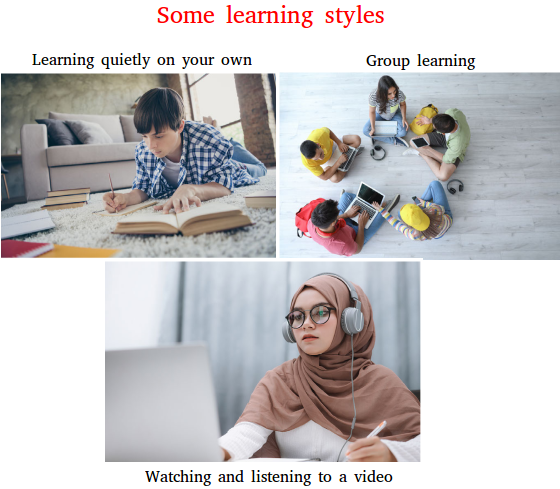This lesson will show you how to learn math, especially when you feel that the battle is lost and you are about to throw in the towel. Take the quiz to find out how to succeed in math!
- Do you find yourself struggling with getting good grades in your math class?
- Is it difficult for you to keep yourself interested when going through exercises in your textbook?
- Do you dread the thought of going to math class?
- Do you experience anxiety while sitting in a math class?

Don’t worry; there’s hope!
You have the potential to learn math, be good at it, and stay good at it. How?
Below are five steps you can take to start learning math or get better at it.
- Understand what you are learning
- Start learning using good strategies
Step 1: Find your motivation!
The key to learning anything, whether it’s riding a bike or playing piano or cooking, is to believe that you can do it. If you believe that one day you’ll be able to make the perfect fried rice, then you’re already one step closer to achieving it. Since you are convinced that your fried rice will taste good, you are motivated to get it done.
It’s the same thing with math. You just have to believe and let go of past negative experiences! Yes, if you believe that one day you’ll have a good understanding of math concepts and mathematics in general, then you are more likely to be motivated and work hard at it.

It’s really all about finding your motivation. You can learn anything as long as you have the motivation to learn it. Just think about the reason why you want to learn math.
Is it to pass a class? Is it to take a test? Is it to train your brain to think more logically and creatively? Is it to prepare yourself for life because you realize that math is in everything?Whatever your reason is, use it to motivate your path forward.
Inspiring Quote:
“Always bear in mind that your own resolution to succeed is more important than any other.” — Abraham Lincoln, 16th President of the United States
Step 2: Stop making excuses!
Some common statements from frustrated students include: “Math is too hard and I’ll never understand how to do this!” and “I don’t like math because I’m just not a math person.”
Excuses, excuses, and more excuses.

To be fair, there is an element of truth in these statements. Math is perceived as difficult by many because it requires a high level of logical thinking. Being able to use mathematical reasoning is a huge part of learning this subject, and this is admittedly difficult. Not everyone thinks in the same way, and it can be challenging to see the reasoning behind why certain things in math are the way they are.
However, saying math is too hard is where the problem lies. Nothing in this world, nothing you are learning, is too hard for you. There’s simply no such thing.
Our brains are meant to learn, to rise to challenges, and to grow in knowledge. We are meant to solve puzzles and to live up to our own potential. Even if you don’t believe it, you have the potential to learn math. There are too many people who fall prey to the common misconceptions surrounding learning math.
If you believe something is too difficult, you’re never going to try it because you’ve already given up and decided for yourself that you can’t do it. But if you start trusting that math is never going to be too hard for you, then you’ll already be one step closer to being good at it. This is known as a growth mindset.
Anything can be learned and understood. If you are truly motivated and are willing to work hard, you can learn anything, including math.
Now, of course, if you suffer from a learning disability of any kind, it will be more difficult for you to tackle certain topics. Still, you shouldn’t be discouraged. There are many with these disabilities who are able to learn and do well at math.
Inspiring Quotes:
“Whether you think you can or you think you can’t, you’re right.” — Henry Ford, founder of Ford Motor Company
“The problem is not the problem. The problem is your attitude about the problem.” — Captain Jack Sparrow, fictional character from Pirates of the Caribbean
Step 3: Find out how you learn
So, you’ve found your motivation to learn, and you’ve gotten rid of your excuses. Now you’re ready to sit down with your textbook and start doing exercises.
Are you?
Notice that the title of this article is to “how to learn math,” not “how to start reading your textbook” or “how to start solving math problems.”
It’s important that you find the best way for you to learn and use that. One of the biggest hindrances to learning new information is that you aren’t taking in the information in the correct way.

As was mentioned, everyone’s brain is different.
Some people absorb information better when they read it, while others are able to use their sense of hearing to learn. Still others have to see it done both ways – reading the information as well as having it explained. So, try to find what works for you, and explore different methods of taking in information.
There are plenty of people who find using videos can be helpful when learning math. Finding a video that can both show you a concept (visual) and explain the concept in an understandable way (auditory) can make learning math easier and more enjoyable.
Finally, you need to know if you learn better by yourself or in a group.
Inspiring Quote:
“You don’t understand anything until you learn it more than one way.” — Marvin Minsky, founder of MIT’s artificial intelligence department
Step 4: Understand what you are learning
Now, the important thing when sitting down to start learning math is to rely on understanding concepts, not rote memorization.
Many of us remember elementary school when we were asked to learn the multiplication tables by heart. Perhaps you recall also those timed tests on paper to see how much you remembered. While this strategy may have taught you that 7 x 6 = 42, how much did you really learn about multiplication from it?
In order for you to learn something about the concept, the teacher most likely combined this method with a fun word problem about 7 friends who each had 6 cookies. As a result, you were able to grasp that multiplication is simply repeated addition.

What’s the point? No matter if the concept is simple, like basic multiplication, or difficult, like polynomial derivation and integration, the strategy behind learning is the same: Understand the concepts.
Why is this important? Math is a subject where if you do not understand a concept, it can be detrimental to your future learning. You must understand addition to understand multiplication, and you must understand algebra to understand linear algebra and pre-calculus to understand calculus. The different levels of math build on one another.
Many people try to learn math by taking shortcuts or learning tricks to help them move faster in the subject. There’s nothing wrong with that, but if you try to take the shortcuts before you have a good understanding of the concept, it may affect you later on when you try to learn something more difficult.
Remember: Math builds on itself. One of the biggest pieces of advice you can take from this is to remember that fact. You will not understand or learn math if you try to take shortcuts too early. Work on understanding the concept and learning it first.
Step 5: Start learning using good strategies
How can you do this?
There are a few good strategies that you can start using during your study sessions.

1. Study with a goal to understand, not to solve.
This literally cannot be emphasized enough. Don’t just memorize the steps to solve a problem. Instead, try to understand why a certain method is being used. Take your time to see how the problem is built.
2. Start simple, and work your way up to harder concepts.
Most math textbooks are built like this already, which makes this strategy easier. The important thing to remember is that if you don’t fully understand what’s in the beginning of the book, you will have a harder time understanding what’s in the next chapter.
Take each concept, for example, as a building block. If you don’t have a good foundation, you can’t just skip over it and start putting the next block on your tower of knowledge.
Math works the same way. Make sure you fully understand one topic before moving on to the next.
3. Use tricks and shortcuts wisely.
There’s always going to be some kind of trick you can find online for how to solve something faster. Just remember that these math tricks are meant for people who have already learned the material. If you use these tricks as a way to speedrun your math lesson, you’ll probably end up being able to do math, but you can’t say that you’ve learned it.
4. Practice, practice, practice.
This is a big one. You can’t get better at anything if you don’t apply what you’ve learned. But practice wisely!
Spending a lot of time doing the same kind of exercises over and over again isn’t practicing wisely. It’s actually a waste of your time.
Try to find varied exercises; for example, word problems and proofs. Look on different websites to get new and creative problems to solve. Test your knowledge of the subject broadly.
If you feel you’ve mastered all the exercises in one area, try a harder problem. Your brain will only grow as you challenge it to think outside the box.
By the way, if you need more exercises, try my interactive quizzes that can usually be found at the end of lessons. These will test more than one skill within the topic.
Inspiring Quote:
“In the end we retain from our studies only that which we practically apply.” — Johann Wolfgang Von Goethe, German poet, author and scientist
5. Be patient.
Nobody becomes good at math in one day. Use these steps and strategies, and don’t worry if you don’t see immediate progress.
It takes hard work to be good at something, especially math. So don’t give up! If you’re truly motivated, you can achieve anything you want.
Of course, if you see that a lot of time has gone by and you’re not seeing progress, it may be time to speak with a teacher or another learning professional. They can offer more tips or varied learning strategies not mentioned here, refer you to a math tutor, or you may be tested for a learning disability.
General tips on how to learn math
Below are some general tips that can help you no matter what you’re trying to learn.
1. Have a quiet and organized work environment.
You learn better when you concentrate on what you are studying. Try to find an area that is clutter and distraction free. Have all your notes and everything you need close to you, including water, snacks, pens, and pencils. That way, you won’t have to get up to retrieve something you’ve forgotten.
If you like listening to music while you work, choose an app that allows you to play music non-stop. It’s very easy to get distracted when you’re scrolling through an app and picking songs.
2. Work efficiently.
Create a schedule for learning that works for you. For example, if you have a goal to study for 3 hours, don’t try to sit at a desk or in a library for 3 hours straight. More than likely, you’ll be distracted after only an hour or two, be frustrated and tired, and probably decide to give up for that day.
Instead, try to break up your study period. Set a timer for a period of time, perhaps half an hour, and study without breaks. There should be absolutely no distractions. Instead, your study session should be focused and effective until the timer rings. Once it does, take a mandatory break. Get up, stretch a little, and maybe check your messages. Set another timer for this break, perhaps about 5 minutes, and stick to it. Then repeat until you’ve reached your target goal.
By splitting your study period into “no distraction study time” and “break time,” you will be more efficient. Studying won’t feel like an endless chore, and you’re more likely to achieve your 3-hour goal.
3. Consistency is key.
Studying and learning anything, math especially, doesn’t happen in one day or one study session. It’s important to be regular with how often you study. Otherwise, you may find yourself forgetting what you learned.
Have a weekly schedule for your practice, and stick to it.
The more you go over what you’ve learned and keep practicing the key concepts, the more likely you are to remember and retain the big ideas of what you’ve been studying.
How to learn math: Key points
In summary, here is how to learn math
If you want to be successful at math, there are five key steps you should take.
First, find your motivation. Keep in mind that you will always need math in your life.
Second, stop disliking math, stop making excuses, and do not believe in some math myths such as only geniuses can learn math.
Third, find out how you learn and use video lectures as much as possible.
Fourth, be sure you understand what you are learning right now before moving on to more complicated topics.
Fifth, use helpful strategies to make the most of your studying. Do not just focus all your energy on tricks or tactics. Try to understand the material as a whole and practice a lot.
Remember, these steps or important strategies apply not just for learning math but for learning anything at all. So if you find yourself struggling with a different subject, use some of these strategies to assist your learning.
A few last words of encouragement:
“An investment in knowledge pays the best interest.” — Benjamin Franklin, scientist and journalist known for being a Founding Father of the United States
“The expert in anything was once a beginner.” — Anonymous
“The greatest teacher, failure is.” — Yoda, fictional character from Star Wars
